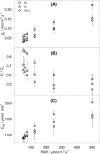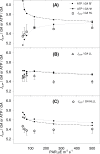Acclimation of C4 metabolism to low light in mature maize leaves could limit energetic losses during progressive shading in a crop canopy
- PMID: 24591058
- PMCID: PMC4085954
- DOI: 10.1093/jxb/eru052
Acclimation of C4 metabolism to low light in mature maize leaves could limit energetic losses during progressive shading in a crop canopy
Abstract
C4 plants have a biochemical carbon-concentrating mechanism that increases CO2 concentration around Rubisco in the bundle sheath. Under low light, the activity of the carbon-concentrating mechanism generally decreases, associated with an increase in leakiness (ϕ), the ratio of CO2 retrodiffusing from the bundle sheath relative to C4 carboxylation. This increase in ϕ had been theoretically associated with a decrease in biochemical operating efficiency (expressed as ATP cost of gross assimilation, ATP/GA) under low light and, because a proportion of canopy photosynthesis is carried out by shaded leaves, potential productivity losses at field scale. Maize plants were grown under light regimes representing the cycle that leaves undergo in the canopy, whereby younger leaves initially developed under high light and were then re-acclimated to low light (600 to 100 μE·m(-2)·s(-1) photosynthetically active radiation) for 3 weeks. Following re-acclimation, leaves reduced rates of light-respiration and reached a status of lower ϕ, effectively optimizing the limited ATP resources available under low photosynthetically active radiation. Direct estimates of respiration in the light, and ATP production rate, allowed an empirical estimate of ATP production rate relative to gross assimilation to be derived. These values were compared to modelled ATP/GA which was predicted using leakiness as the sole proxy for ATP/GA, and, using a novel comprehensive biochemical model, showing that irrespective of whether leaves are acclimated to very low or high light intensity, the biochemical efficiency of the C4 cycle does not decrease at low photosynthetically active radiation.
Keywords: Bundle sheath; PPFD.; efficiency; irradiance; isotopic discrimination; leakiness; low light; mesophyll; Δ 13C.
© The Author 2014. Published by Oxford University Press on behalf of the Society for Experimental Biology.
Figures





References
-
- Badger MR. 1985. Photosynthetic oxygen exchange. Annual Review of Plant Physiology 36, 27–53
-
- Baker NR, Long SP, Ort DR. 1988. Photosynthesis and temperature, with particular reference to effects on quantum yield. In: Long SP, Woodward FI, eds. Plants and Temperature: Society for Experimental Biology Symposium No XXXXII. Cambridge: Company of Biologists, 347–375 - PubMed
-
- Barbour MM, McDowell NG, Tcherkez G, Bickford CP, Hanson DT. 2007. A new measurement technique reveals rapid post-illumination changes in the carbon isotope composition of leaf-respired CO2 . Plant Cell and Environment 30, 469–482 - PubMed
-
- Bellasio C, Griffiths H. 2013. Acclimation to low light by C4 maize: implications for bundle sheath leakiness. Plant Cell and Environment doi: 10.1111/pce.12194. - PubMed
Publication types
MeSH terms
Substances
LinkOut - more resources
Full Text Sources
Other Literature Sources
Miscellaneous

